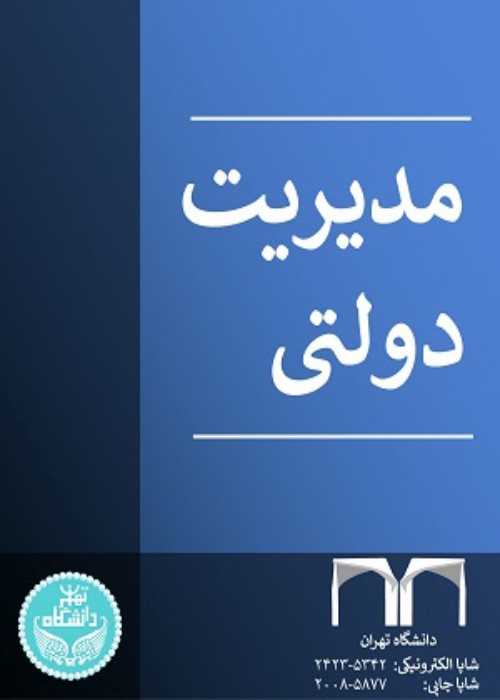Investigating the Susceptibility of Human Resource Management to the Internet of Things
Author(s):
Article Type:
Research/Original Article (دارای رتبه معتبر)
Abstract:
Objective
As the Internet of Things (IoT) continues to rapidly develop, businesses are increasingly investing in incorporating it into their processes. However, many companies have yet to adopt this technology in their human resource management practices due to a lack of clear understanding of its potential applications in this area. This is largely due to the limited research literature available on the subject. This research aims to develop a conceptual framework that describes the potential applications of the Internet of Things in human resource management. Additionally, the study aims to raise awareness among businesses about the various benefits that can be gained through the implementation of this technology in their human resource processes.Methods
In this research, firstly, previous studies conducted on the subject were reviewed. Secondly, to answer the main question of the research, semi-structured interviews were conducted with nine experts in the fields of the Internet of Things and human resources management based on the snowball method. The achieved data were analyzed by conducting a thematic analysis and coding the data with MAXQDA software.Results
The main human resource management processes in which the applications of the Internet of Things were identified by the current research include six key areas; 1. recruitment, 2. training and development, 3. performance management, 4. service compensation, 5. maintenance, and 6. termination of service. These applications in the mentioned processes respectively included 1.1. Collecting and analyzing the conscious and unconscious data of employees to offer cooperation opportunities to the elite workforce 1.2. Selecting and attracting the most qualified applicants to the organization 1.3. Compilation of productive work schedule of employees 1.4. Creating the possibility of remote interviews with job seekers and reducing recruitment costs in this way, 2.1. Assessing the needs of employees for training programs after analyzing their performance 2.2. Identifying highly stressed and aggressive employees and providing them with stress and anger management courses 2.3. Improving the self-assessment skills of employees and helping their personal growth and development through it, 3.1. Smartening and automating employee performance control and making it free from any human errors 3.2. Establishing a fair and justice-oriented evaluation of the performance of employees 3.3. Making it possible for employees to evaluate the organization's performance, 4.1. Creating a reward system based on employee performance and encouraging or punishing them accordingly 4.2. Promotion or job rotation of employees after analyzing their behavioral data 4.3. Providing facilities and benefits according to individual tendencies and interests of employees, 5.1. Monitoring the health and physical condition of employees through smart watches and bracelets 5.2. Warning the employees or the manager of the relevant unit when one of the employees is in unfavorable physical conditions 5.3. Ensuring the safety of employees by foreseeing workplace accidents 5.4. Facilitating the daily activities of employees through the intelligentization of the work environment 5.5. Arranging employees in organizational units logically and appropriately after identifying the existing communication patterns among them, 6.1. Identifying employees who are inclined to leave the organization and preventing them from doing so by providing valuable suggestions to them which can result in a reduced rate of leaving the organization, and 6.2. Not losing touch with employees during and after the off-boarding process.Conclusion
The Internet of Things causes more effective and more efficient management of human resources through the intelligentization of HRM processes and making them data-driven and free from any human errors.Language:
Persian
Published:
Quarterly Journal Public Administration, Volume:15 Issue: 54, 2023
Pages:
344 to 363
magiran.com/p2632623
دانلود و مطالعه متن این مقاله با یکی از روشهای زیر امکان پذیر است:
اشتراک شخصی
با عضویت و پرداخت آنلاین حق اشتراک یکساله به مبلغ 1,390,000ريال میتوانید 70 عنوان مطلب دانلود کنید!
اشتراک سازمانی
به کتابخانه دانشگاه یا محل کار خود پیشنهاد کنید تا اشتراک سازمانی این پایگاه را برای دسترسی نامحدود همه کاربران به متن مطالب تهیه نمایند!
توجه!
- حق عضویت دریافتی صرف حمایت از نشریات عضو و نگهداری، تکمیل و توسعه مگیران میشود.
- پرداخت حق اشتراک و دانلود مقالات اجازه بازنشر آن در سایر رسانههای چاپی و دیجیتال را به کاربر نمیدهد.
In order to view content subscription is required
Personal subscription
Subscribe magiran.com for 70 € euros via PayPal and download 70 articles during a year.
Organization subscription
Please contact us to subscribe your university or library for unlimited access!


